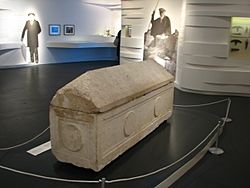Helena of Adiabene facts for kids
Quick facts for kids Helena of Adiabene |
|
|---|---|
| Queen of Adiabene and Edessa | |

Sarcophagus of Helena, Israel Museum
|
|
| Died | 50–56 CE |
| Burial | Jerusalem |
| Spouse | Monobaz I and Abgar V |
| Issue | Izates bar Monobaz and Monobaz II |
| Religion | Convert to Judaism |
Helena of Adiabene (Hebrew: הִילְנִי Hīlənī; died around 50–56 CE) was a powerful queen mother from the ancient kingdom of Adiabene. This kingdom was a vassal state of the Parthian Empire, located in what is now Erbil, Iraqi Kurdistan.
Helena was married to her brother, Monobaz I. Together, they were the parents of two important sons: Izates II and Monobaz II. Around 30 CE, Helena made a significant decision to convert to Judaism. Some historical accounts suggest she was the daughter of King Izates. Other sources, like Moses of Chorene, describe her as the main wife of Abgar V, who was the king of Edessa.
Contents
Helena's Life and Generosity
Helena of Adiabene was well-known for her kindness and generosity. During a severe famine in Jerusalem around 45–46 CE, she took action to help those suffering. She sent for large amounts of corn (grain) from Alexandria in Egypt. She also ordered dried figs from Cyprus to be given out to the people who were struggling to find food.
The Talmud, a collection of Jewish teachings, also mentions her generosity. It states that she gave valuable gifts to the Temple in Jerusalem. Helena had a large golden candlestick made and placed above the Temple door. When the sun rose, its light reflected off the candlestick. This reflection helped people know it was time to read the Shema, an important Jewish prayer. She also created a golden plate with a passage from the Torah written on it.
Her Dedication to Jewish Law
Helena was very strict in following Jewish law. The Talmud shares stories that show her deep commitment.
Helena's Nazirite Vow
One story tells that her son, Izates, went to war. Helena made a special promise, called a Nazirite vow. She vowed that if her son returned safely, she would live as a Nazirite for seven years. A Nazirite is someone who takes a special vow to dedicate themselves to God, often involving not cutting their hair or drinking wine.
When her son returned safely, she kept her promise. After seven years, she traveled to Judea. However, the religious leaders from the School of Hillel told her she needed to start her vow again. So, she lived as a Nazirite for another seven years. At the end of this second period, she accidentally became ritually impure. This meant she had to repeat her Naziriteship again, making her a Nazirite for a total of twenty-one years.
Queen Helena's Sukkah
Another story from the Talmud describes Queen Helena's sukkah. A sukkah is a temporary hut built for the Feast of Tabernacles, a Jewish holiday. Rabbi Judah mentioned that Queen Helena's sukkah in Lydda was taller than twenty ells (an ancient unit of length). Despite its unusual height, the rabbis would enter and leave it without making any negative comments. This shows that her sukkah was considered acceptable under Jewish law.
Helena's Burial Place
Helena eventually moved to Jerusalem. She was buried in a large, pyramid-shaped tomb that she had built during her lifetime. This tomb is located north of Jerusalem. Today, these ancient burial caves are known as the "Tombs of the Kings."
Inside the tomb, a sarcophagus (a stone coffin) was found with two inscriptions. These inscriptions, in ancient languages, are believed to mean "Our mistress, the Queen." This sarcophagus is thought to belong to Queen Helena of Adiabene.
The sarcophagus was discovered in the 19th century by Louis Felicien de Saulcy. He believed the bones inside belonged to a queen from an earlier period. However, the discovery caused upset among the Jewish community of Jerusalem, and the excavation had to stop. The sarcophagus and other findings were later sent to France and are now displayed at the Louvre Museum.
The Royal Palace of Queen Helena
Archaeologist Doron Ben-Ami believes he discovered the royal palace of Queen Helena in 2007. This discovery was made during excavations in the City of David, an ancient part of Jerusalem.
According to the historian Josephus, the palace was a very large building. It was located in the City of David, just south of the Temple Mount. The Romans destroyed this palace in 70 CE. The ruins of the palace contained old coins, stone vessels, pottery, and pieces of ancient wall paintings. The basement level of the palace also had a mikveh, which is a ritual bath used for purification in Judaism.
Images for kids
See also
 In Spanish: Helena de Adiabene para niños
In Spanish: Helena de Adiabene para niños





